Wavelet Filter Banks in Perceptual Audio Coding
This thesis studies the application of the wavelet filter bank (WFB) in perceptual audio coding by providing brief overviews of perceptual coding, psychoacoustics, wavelet theory, and existing wavelet coding algorithms. Furthermore, it describes the poor frequency localization property of the WFB and explores one filter design method, in particular, for improving channel separation between the wavelet bands. A wavelet audio coder has also been developed by the author to test the new filters. Preliminary tests indicate that the new filters provide some improvement over other wavelet filters when coding audio signals that are stationary-like and contain only a few harmonic components, and similar results for other types of audio signals that contain many spectral and temporal components. It has been found that the WFB provides a flexible decomposition scheme through the choice of the tree structure and basis filter, but at the cost of poor localization properties. This flexibility can be a benefit in the context of audio coding but the poor localization properties represent a drawback. Determining ways to fully utilize this flexibility, while minimizing the effects of poor time-frequency localization, is an area that is still very much open for research.
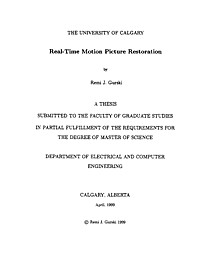
Real-time Motion Picture Restoration
Through age or misuse, motion picture films can develop damage in the form of dirt or scratches which detract from the quality of the film. Removal of these artifacts is a worthwhile process as it makes the films more visually attractive and extends the life of the material. In this thesis, various methods for detecting and concealing the effects of film damage are described. Appropriate algorithms are selected for implementation of a system, based on a TMS320C80 video processor, which can remove the effects of film defects using digital processing. The restoration process operates in real-time at video frame rates (30 frames per second). Details of the software implementation of this system are presented along with results from processing damaged film material. The effects of damage are significantly reduced after processing.
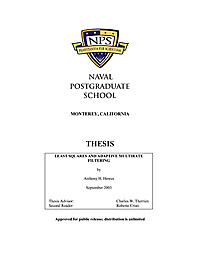
Least Squares and Adaptive Multirate Filtering
This thesis addresses the problem of estimating a random process from two observed signals sampled at different rates. The case where the low–rate observation has a higher signal–to– noise ratio than the high–rate observation is addressed. Both adaptive and non–adaptive filtering techniques are explored. For the non–adaptive case, a multirate version of the Wiener–Hopf optimal filter is used for estimation. Three forms of the filter are described. It is shown that using both observations with this filter achieves a lower mean–squared error than using either sequence alone. Furthermore, the amount of training data to solve for the filter weights is comparable to that needed when using either sequence alone. For the adaptive case, a multirate version of the LMS adaptive algorithm is developed. Both narrowband and broadband interference are removed using the algorithm in an adaptive noise cancellation scheme. The ability to remove interference at the high rate using observations taken at the low rate without the high–rate observations is demonstrated.
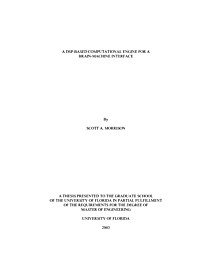
A DSP-Based Computational Engine For a Brain-Machine Interface
The fields of neurobiology and electrical engineering have come together to pursue an integrated Brain-Machine Interface (BMI). Signal processing methods are used to find mapping algorithms between motor cortex neural firing rate and hand position. This cognitive extension could help patients with quadriplegia regain some independence using a thought-controlled robot arm. Current signal processing methods to achieve realtime neural-to-motor translation involve large, multi-processor systems to produce motor control parameters. Eventually, software running in a portable signal processing system is needed to allow for the patient to have the BMI in a backpack or attached to a wheelchair. This thesis presents a DSP-Based Computational Engine for a Brain-Machine Interface. The development of a DSP Board based on the Texas Instruments TMS320VC33 DSP will be presented, along with implementations of two digital filters and their training methods: 1) FIR trained with Normalized Least Mean Square Adaptive Filter (NLMS) and 2) Recurrent Multi-Layer Perceptron (RMLP) trained with Real-Time Recurrent Learning (RTRL). The requirements of the DSP Board, component selection and integration, and control software are discussed. The DSP implementations of the digital filters are presented, along with performance and timing analysis in real data collected from an Owl Monkey at Duke University. The weights of the FIR-NLMS filter converged similarly on the DSP as they did in MATLAB. Likewise, the weights of the RMLP-RTRL filter converged similarly on the DSP as they did using the Backpropagation Through Time method in NeuroSolutions. The custom DSP Board and two digital algorithms implemented in this thesis create a starting point for an integrated, portable, real-time signal processing solution for a Brain-Machine Interface.
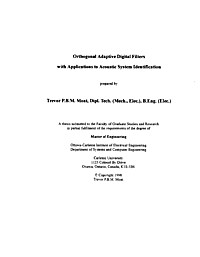
Orthogonal Adaptive Digital Filters with Applications to Acoustic System Identification
The Transform-Domain LMS Algorithm (Narayan, 1983) is studied in the context of an acoustic system identification problem. The power estimator in this two-stage digital filter is shown to affect the achievable rates and depths of convergence significantly. Preferred values for the two tracking parameters, $\beta$ and $\mu,$ are determined. Dynamic Step-size Initialization is proposed to improve early convergence by accelerating the rate at which true power measurements replace (arbitrary) initial values. Later, linear estimators are shown to be sub-optimal, particularly where the spectral distribution of the reference changes rapidly. A simple non-linear Peak Window Power Estimator which eliminates these problems is described. It will be shown to improve the tracking rates and misadjustment simultaneously. The benefits of these methods are demonstrated using FIR sequences representative of typical acoustic environments and using recordings from a commercial telephone set. The proposed structures surpass theexisting algorithms consistently under all circumstances tested.
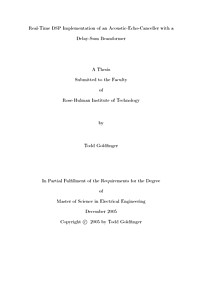
Real-Time DSP Implementation of an Acoustic-Echo-Canceller with a Delay-Sum Beamformer
Traditional telephony uses only a single receiver for speech acquisition. If the speaker is standing away from the telephone, the signal will be weak and there will be interference sources from room reverberation. In addition, there is acoustic echo coming from the loudspeaker, which further interferes with the signal of interest. This research investigated the combination of common solutions to these problems. Electronic beamforming steered an array of microphones within software to enhance the signal power. Echo cancellation removed the echo coming from the loudspeaker. In combination these processing techniques can greatly enhance user experience.

Least Squares and Adaptive Multirate Filtering
This thesis addresses the problem of estimating a random process from two observed signals sampled at different rates. The case where the low–rate observation has a higher signal–to– noise ratio than the high–rate observation is addressed. Both adaptive and non–adaptive filtering techniques are explored. For the non–adaptive case, a multirate version of the Wiener–Hopf optimal filter is used for estimation. Three forms of the filter are described. It is shown that using both observations with this filter achieves a lower mean–squared error than using either sequence alone. Furthermore, the amount of training data to solve for the filter weights is comparable to that needed when using either sequence alone. For the adaptive case, a multirate version of the LMS adaptive algorithm is developed. Both narrowband and broadband interference are removed using the algorithm in an adaptive noise cancellation scheme. The ability to remove interference at the high rate using observations taken at the low rate without the high–rate observations is demonstrated.
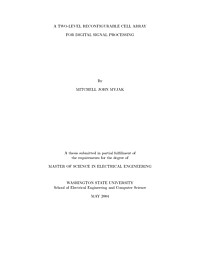
A Two-Level Reconfigurable Cell Array for Digital Signal Processing
Reconfigurable hardware has become an attractive option for implementing digital signal processing, especially in systems that require both high performance and flexibility. This thesis presents a novel two-level reconfigurable architecture targeted toward systems with these requirements. The architecture supports a large orthogonal design space whereby designers can customize the word length, amount of parallelism, number of functional units, and functional unit connectivity to meet the needs of the application. On the upper level, algorithms are mapped onto an array of 4-bit cells and a hierarchical interconnection fabric. The interconnection structure contains a mesh of 4-bit busses for local data transfer, as well as an H-tree for communicating results between functional units. On the lower level, each cell contains a small matrix of elements that collectively implement all necessary operations. The matrix of elements has only two configurations: one optimized for mathematical functions such as multiply-accumulates, and the other optimized for memory operations. The system also contains pipeline latches to maximize clock rate and throughput. Circuit simulations indicate that the architecture achieves a clock frequency of 200 MHz in a modest 0.25-μm CMOS technology. An initial prototype of the reconfigurable cell has been fabricated in 0.5-μm CMOS and tested for functionality. The estimated execution time for a 16-bit, 256-point Fast Fourier Transform shows a speedup ranging from 1.6 to 14 compared to contemporary digital signal processors.
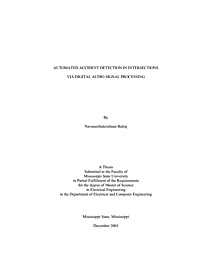
Automated Accident Detection in Intersections Via Digital Audio Signal Processing
The aim of this thesis is to design a system for automated accident detection in intersections. The input to the system is a three-second audio signal. The system can be operated in two modes: two-class and multi-class. The output of the two-class system is a label of “crash” or “non-crash”. In the multi-class system, the output is the label of “crash” or various non-crash incidents including “pile drive”, “brake”, and “normal-traffic” sounds. The system designed has three main steps in processing the input audio signal. They are: feature extraction, feature optimization and classification. Five different methods of feature extraction are investigated and compared; they are based on the discrete wavelet transform, fast Fourier transform, discrete cosine transform, real cepstrum transform and Mel frequency cepstral transform. Linear discriminant analysis (LDA) is used to optimize the features obtained in the feature extraction stage by linearly combining the features using different weights. Three types of statistical classifiers are investigated and compared: the nearest neighbor, nearest mean, and maximum likelihood methods. Data collected from Jackson, MS and Starkville, MS and the crash signals obtained from Texas Transportation Institute crash test facility are used to train and test the designed system. The results showed that the wavelet based feature extraction method with LDA and maximum likelihood classifier is the optimum design. This wavelet-based system is computationally inexpensive compared to other methods. The system produced classification accuracies of 95% to 100% when the input signal has a signal-to-noise-ratio of at least 0 decibels. These results show that the system is capable of effectively classifying “crash” or “non-crash” on a given input audio signal.
Wavelet Filter Banks in Perceptual Audio Coding
This thesis studies the application of the wavelet filter bank (WFB) in perceptual audio coding by providing brief overviews of perceptual coding, psychoacoustics, wavelet theory, and existing wavelet coding algorithms. Furthermore, it describes the poor frequency localization property of the WFB and explores one filter design method, in particular, for improving channel separation between the wavelet bands. A wavelet audio coder has also been developed by the author to test the new filters. Preliminary tests indicate that the new filters provide some improvement over other wavelet filters when coding audio signals that are stationary-like and contain only a few harmonic components, and similar results for other types of audio signals that contain many spectral and temporal components. It has been found that the WFB provides a flexible decomposition scheme through the choice of the tree structure and basis filter, but at the cost of poor localization properties. This flexibility can be a benefit in the context of audio coding but the poor localization properties represent a drawback. Determining ways to fully utilize this flexibility, while minimizing the effects of poor time-frequency localization, is an area that is still very much open for research.
A Prototype Laboratory Environment for Digital Signal Processing Using Simulink and a Texas Instrument DSP Device
Normally, when a model is designed from building blocks in Simulink, the simulation is performed within the Simulink environment. A test of the design in a real-time environment requires that source code is generated, compiled and downloaded to the target hardware. As a first attempt to bridge this software gap, this thesis describes and evaluates a prototype laboratory environment, which directly links Simulink to a Texas Instrument DSP device. The prototype system converts graphical models and makes available various real-time signal processing algorithms, such as adders, delays, FFTs, IIR filters and multipliers. Future work is to consider modification of the prototype to allow for feedback in the graphical models and to find an efficient way of handling signal processing algorithms where variable buffer lengths are required.
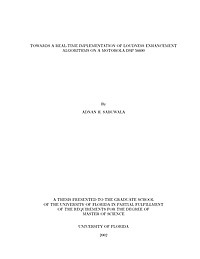
Towards a Real-Time Implementation of Loudness Enhancement Algorithms on a Motorola DSP 56600
Most of the cellular phone companies with audio speaker capabilities focus on reducing the current drain to extend battery life. None of these companies concentrate on modifying the speech signal itself to make it sound louder in noisy listener environments without adding additional energy. Such algorithms have been described in literature by Boillot and form the backbone of this thesis. The current project focusses on taking a step towards running these algorithms in real-time on a 16-bit fixed point Motorola DSP 56600. Implementation of the autocorrelation, Levinson- Durbin, FIR, and IIR filters in assembly for the Motorola DSP 56600 has been investigated in the thesis. The challenges and alternate solutions to circumvent the challenges have been described, and experimental results have been presented. Results indicate that the modified signed LMS algorithm, which can be considered to be a blend between the LMS and signed LMS algorithms, turns out to be an elegant solution to circumvent the challenges in implementing the Levinson-Durbin recursion.



















